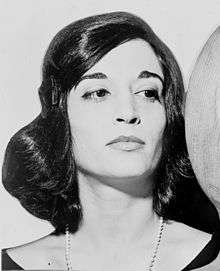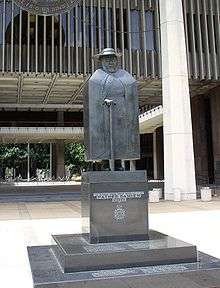Marisol Escobar
| Marisol Escobar | |
|---|---|
 Marisol Escobar (1963) | |
| Born |
May 22, 1930 Paris, France |
| Died |
April 30, 2016 (aged 85) New York, New York, US |
| Education |
Jepson Art Institute École des Beaux-Arts Art Students League of New York Hans Hofmann School |
| Known for |
Sculpture Assemblage |
| Notable work |
The Last Supper Dust Bowl Migrants Father Damien |
| Movement | New Realism |
| Awards |
1997 Premio Gabriela Mistral, from Organization of American States American Academy of Arts and Letters (1978) |

Marisol Escobar (May 22, 1930 – April 30, 2016), otherwise known simply as Marisol, was a French sculptor of Venezuelan heritage who worked in New York City.[1]
Education
Marisol Escobar studied art at the Jepson Art Institute, École des Beaux-Arts, the Art Students League of New York, at the New School for Social Research and she was a student of artist Hans Hofmann. The pop art culture in the 1960s found Marisol as one of its members, enhancing her recognition and popularity. She concentrated her work on three-dimensional portraits, using inspiration “found in photographs or gleaned from personal memories”.[2]
Her religious beliefs might very well have had a great deal of influence upon her character and tendencies toward the arts. Her father moved Marisol, at age 16, and her brother (Gustavo) to Los Angeles where she began her study in the arts, after World War II and also their mother’s suicide.[3] She began practice in painting and drawing during her teen years. It was during these years she admitted self-inflicted acts of penance upon herself.[4] She walked on her knees until they bled, kept silent for long periods and tied ropes tightly around her waist in emulation of saints and martyrs. Her father reinforced her interest in art and supported Marisol in her decision to continue along its course. Her mother, Josefina, had been a well known patron of the arts in Venezuela. Marisol studied in Paris in 1949, returning to study in New York in 1950.[5]
Artistic beginnings
From 1951 to 1954 she took courses at the New School for Social Research while studying under her most influential mentor, the so-called "dean of Abstract Expressionism", Hans Hofmann. At Hofmann’s schools in Greenwich Village and Provincetown, Massachusetts, Marisol became acquainted with notions of the "push and pull" dynamic: of forcing dichotomies between raw and finished states. During this period, Marisol was introduced to New York's Cedar Tavern, the chief watering hole for many of the leading Abstract Expressionists with whom Marisol became friends, particularly Willem de Kooning.
Early career
It was in 1951, when Marisol discovered pre-Columbian artifacts, that she decided to give up painting and shift her focus to sculpture. Many of her early paintings remain in the hands of friends and are rarely sold, making them difficult to assess. Marisol’s new inclination led her to work with terracotta and wood. She remained primarily self-taught in sculpture, though she studied one clay course in a New York institution. Her first exhibition was in the new Leo Castelli Gallery in New York in 1958, and it met with success.
However, Marisol found herself plagued with self-doubt, left for five years travel abroad to analyze herself and her work.[3] She successfully freed her doubts and honed her skills.[4] Moving back to New York City, she found a tremendous amount of success, culminating in her work finding home in a number of prestigious museums. Marisol sought to envelop herself in the area of abstract expressionism. “The heavy seriousness of this movement prompted Marisol to seek humor in her own work, which was essentially carved and drawn-on self-portraiture."[4]
Pop art
It was in the following decade of the 1960s that Marisol began to be influenced by pop artists such as Andy Warhol and Roy Lichtenstein. She appeared in two films by Warhol, The Kiss and 13 Most Beautiful Girls.[3][6] One of her best-known works from this period is The Party, a life-size group installation of figures at the Toledo Museum of Art. All the figures, gathered together in various guises of the social elite, sport Marisol’s face. It is intriguing to note that Marisol dropped her family surname of Escobar in order to divest herself of a patrilineal identity and to "stand out from the crowd."[6]
Marisol drifted through many movements. "'Not Pop, Not Op, It's Marisol!' was the way Grace Glueck titled her article in the New York Times in 1965…"[2] Silence was an integral part of Marisol’s work and life. She was said to have spoken no more than she needed to and in her work she been described as having to bestowed silence with, "form and weight". She talked little of her career and once stated, "I have always been very fortunate. People like what I do."[2]
In 1966-67, she completed Hugh Hefner, a sculptural portrait of the celebrity magazine publisher. She depicted him with two copies of his trademark smoking pipe, one painted, and the other a real one projecting aggressively from the front of the piece. The sculpture was featured on the March 3, 1967 cover of Time magazine.[7] The work was acquired by Time, and is now in the collection of the National Portrait Gallery of the Smithsonian Institution.[8] Curator Wendy Wick Reaves said that Escobar is "always using humor and wit to unsettle us, to take all of our expectations of what a sculptor should be and what a portrait should be and messing with them. So when she's asked why there are two pipes, she says, 'Well, Hugh Hefner has too much of everything.'"[9]
Marisol’s diversity, unique eye and character set her apart from any one school of thought. She has often included portraits of public figures, family members and friends in her sculpture. In one exhibit, “Marisol Escobar's The Kennedys criticized the larger-than-life image of the family” (Walsh, 8). In 1982-1984, her respect for Leonardo da Vinci led her to make a life-sized sculptural representation of herself contemplating her full-sized tableau of The Last Supper.[10] She also did a work based on da Vinci's The Virgin with St. Anne.[2]
Late career
Marisol received awards including the 1997 Premio Gabriela Mistral from the Organization of American States for her contribution to Inter-American culture.[11] She was elected to membership in the American Academy of Arts and Letters in 1978.[12]
In 2004, Marisol's work was featured in "MoMA at El Museo", an exhibition of Latin American artists held at the Museum of Modern Art.[13] Marisol's work has attracted increased interest, including a major retrospective in 2014 at the Memphis Brooks Museum of Art in Memphis, Tennessee,[3] which also became her first solo show in New York City, at Museo del Barrio.[14]
She last lived in the TriBeCa district of New York City, and was in frail health towards the end of her life.[3]
Marisol died on April 30, 2016 in New York City from pneumonia, aged 85.[15][5]
See also
References
- ↑ "Falleció la escultora venezolana Marisol Escobar a sus 86 años de edad". noticias24.com. Retrieved 2 May 2016.
- 1 2 3 4 Gardner, Paul. "Who is Marisol?" ARTnews 88 May 1989, pp. 12-15.
- 1 2 3 4 5 Smee, Sebastian (July 5, 2014). "Revisiting Marisol, years after her heyday". Boston Globe. Boston Globe Media Partners LLC. Retrieved 2014-07-06.
- 1 2 3 Westmacott, Jean. "Marisol Escobar, Pop Art." New York: W. W. Norton & Company, 1989, pp. 20, 23-24.
- 1 2 Grimes, William (2 May 2016), Marisol, an Artist Known for Blithely Shattering Boundaries, Dies at 85, The New York Times, retrieved 3 May 2016
- 1 2 "Escobar, Marisol." The Hutchinson Encyclopedia. September 22, 2003
- ↑ "Hugh Hefner". Time. Time, Inc. Retrieved 2014-07-30.
- ↑ "Hugh Hefner". Face Value: Portraiture in the Age of Abstraction. Smithsonian Institution. Retrieved 2014-07-24.
- ↑ Stamberg, Susan (May 29, 2014). "As Portraits Became Passé, These Artists Redefined 'Face Value'". NPR. National Public Radio. Retrieved 2014-07-24.
- ↑ "Self–Portrait Looking at The Last Supper". The Metropolitan Museum of Art. The Metropolitan Museum of Art. Retrieved 2014-07-06.
- ↑ "Artnet News". artnet. June 11, 1998.
- ↑ "Current Members". American Academy of Arts and Letters. American Academy of Arts and Letters. Retrieved 7 March 2015.
- ↑ Remeseira, Claudio Iván (2010-01-01). Hispanic New York a sourcebook. New York: Columbia University Press. ISBN 9780231148184.
- ↑ "Marisol: Sculptures and Works on Paper | El Museo del Barrio". www.elmuseo.org. Retrieved 2016-05-02.
- ↑ Embuscado, Rain (2 May 2016). "Beloved Artist Marisol Escobar Dies at 85 - artnet News". artnet News. Retrieved 2016-05-02.
Works cited
- Avis Berman, "A Bold and Incisive Way of Portraying Movers and Shakers." Smithsonian, February 14, 1984: pp. 14-16.
- “Escobar, Marisol.” The Hutchinson Encyclopedia. September 22, 2003
- Gardner, Paul "Who is Marisol?" ARTnews 88 May 1989: pp. 12–15.
- “Marisol.” The Columbia Encyclopedia. Sixth Edition; April 22, 2004.
- Walsh, Laura. “Life of JFK depicted through art at Bruce Museum Exhibit”, AP Worldstream September 19, 2003: pg. 8.
- Westmacott, Jean. Marisol Escobar, Pop Art. New York: W. W. Norton & Company, 1989.
- "Marisol Escobar- Biography", Rogallery, n.d. Web. September 21, 2015.
External links
- Artnet news obituary
- Articite entry (French language)
- Artcyclopedia entry
- Latin Art Museum page in Spanish
- Museum of Modern Art collections, New York City
- Pop Art biography
- Sculpture: Portrait of Georgia O'Keeffe, Cast Bronze, 1982